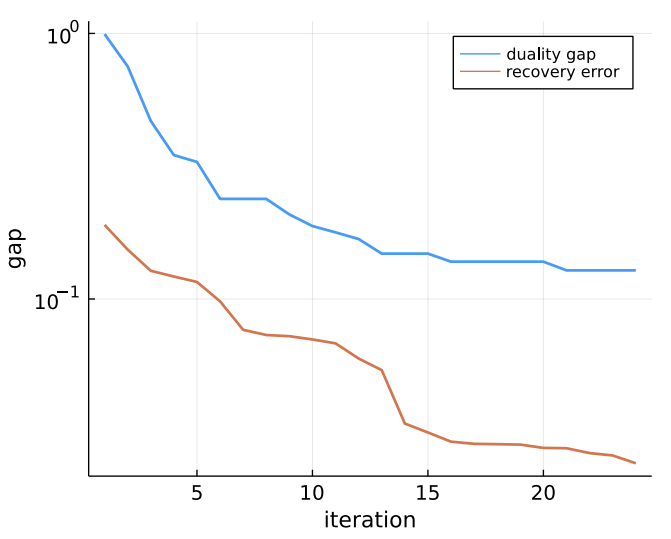Polar Alignment
and
Primal Retrieval
Zhenan Fan
Department of Computer Science
Collaborators:
Huang Fang, Yifan Sun, Halyun Jeong, Michael Friedlander

Atomic Decomposition
[Chen, Donoho & Sauders'01; Chandrasekaran et al.'12]
- sparse n-vectors
-
low-rank matrices
How do we identify the support of a vector x with respect to an arbitrary atomic set A?
cardinality
atomic set
weight
atom

Gauge and Support Functions
Gauge function
Support function


Polar Alignment
Polar inequality
Alignment
Theorem

Examples
Sparse vector
Low-rank Matrix
X has rank r
largest singular value of Z has multiplicity d

Alignment in Structured Optimization
(P1)
(P2)
(P3)
Theorem
(y* is same as optimal dual variable up to proper scaling.)

Extension to Sum of Sets
Theorem
(P1)
(P2)
(P3)

Cardinality-Constrained Data-Fitting
Assumption
(P)
is feasible to (P)
Dual problem
Goal retrieve a primal variable near-feasible to (P) from a near-optimal dual variable

Primal Retrieval
Essential Cone of Atoms
Primal retrieval
(PR)
Key Idea
(PR) is easy to solve when k is small
is feasible to (P)

Polyhedral Atomic Set
(PR)
can be removed when A is symmetric
Theorem
Suppose the primal problem is non-degenerate
(duality gap)

Experiment: Basis Pursuit Denoise
(P)
Test problems from Sparco [van den Berg et al.'09]


Spectral Atomic Set
(PR)
Theorem

Experimet: Low-Rank Matrix Completion
(P)

Simiar experiment as in [Candès & Plan'10]
( from National Centers for Environmental Information)
is approximately low-rank
We subsample 50% of
Alignment and Retrieval
By Zhenan Fan
Alignment and Retrieval
Slides for alignment.
- 244



